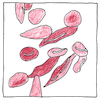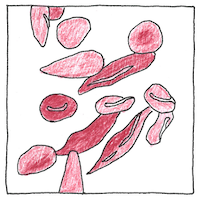Linus Pauling
molecular biology

|
Sickle-cell disease
Sufferers of sickle-cell disease, Linus Pauling found, have different haemoglobin molecules. This haemoglobin forms strands that deform red-blood cells, decreasing their elasticity, restricting the flow of blood, carry oxygen less efficiently and are destroyed sooner, resulting in severe anaemia, blocking small blood vessels, restricting oxygen to the organs, destroys the spleen, increases the risk of infection, and damages the kidneys and liver.
Resistance
In the evil balance of nature sickle-cell disease persists as the abnormality gives resistance when inherited from only one parent to the malarial parasite.
Suffering
Real crippling pain not psychological. We can replenish the blood or treat the symptoms or for children do bone-marrow transplants. Cruel and arbitrary yet impossible to refute.



James B. Herrick described the sickle-cell disease in 1904. Linus Pauling’s finding, in 1949, was the first to link a genetic disease to a mutation of a specific protein. In 1954, Vernon Ingram showed that the DNA of sickle-cell haemogloblin varied from normal haemogloblin by one amino-acid, only one letter in the DNA code. Except for bone-marrow transplants for children, there is no cure for sickle-cell disease.
See also in The book of science:
Readings in wikipedia: